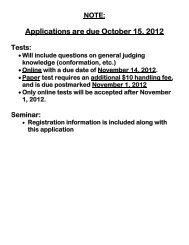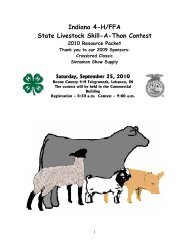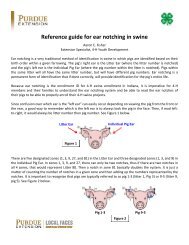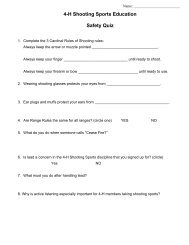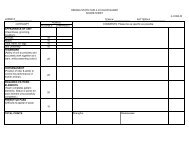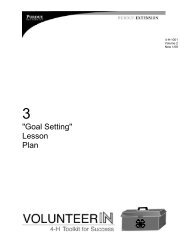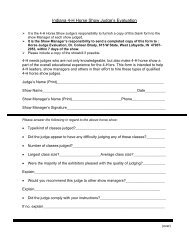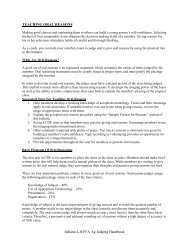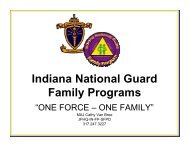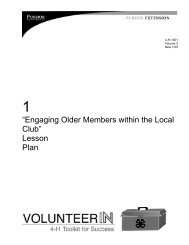Why there is Parliamentary Procedure - Indiana 4-H
Why there is Parliamentary Procedure - Indiana 4-H
Why there is Parliamentary Procedure - Indiana 4-H
Create successful ePaper yourself
Turn your PDF publications into a flip-book with our unique Google optimized e-Paper software.
<strong>Why</strong> <strong>there</strong> <strong>is</strong> <strong>Parliamentary</strong> <strong>Procedure</strong><br />
Do you remember a time in which you joined a conversation<br />
among several people? In that group was an individual or two who<br />
seemed to do all the talking. It was difficult, if not impossible, for<br />
you to make a statement, state your ideas or participate in any<br />
way. Consider what would happen if instead of joining a<br />
conversation, you were attending a meeting at which some goal or<br />
objective was to be accompl<strong>is</strong>hed. How would you feel if you were<br />
unable to state your view? <strong>Parliamentary</strong> procedure makes it<br />
possible for you, or anyone to be heard. <strong>Parliamentary</strong> procedure<br />
<strong>is</strong> an organized way in which the smallest minority (even just one<br />
person) can be heard, while preserving the right of the majority to<br />
prevail. Think of the difficulties of conducting business to arrive at<br />
a dec<strong>is</strong>ion if parliamentary procedure <strong>is</strong> not used. And think of<br />
how short, productive and easy business meetings become when<br />
<strong>Parliamentary</strong> procedure <strong>is</strong> used. It <strong>is</strong> important for leaders and<br />
members alike to know how to conduct business meetings.<br />
What are the rules of <strong>Parliamentary</strong> <strong>Procedure</strong>? One of the oldest<br />
and most popular set <strong>is</strong> Robert’s Rules of Order. It <strong>is</strong> the set of rules<br />
used by most leg<strong>is</strong>lative bodies. Most of the time meetings are<br />
small groups and <strong>is</strong>sues are not contentious. In these cases only a<br />
few simple rules are needed. Often consensus (another method of<br />
conducting meetings) can be used to arrive at a dec<strong>is</strong>ion. But if a<br />
dec<strong>is</strong>ion <strong>is</strong> to be made on a difficult <strong>is</strong>sue, it becomes necessary to<br />
strictly follow Robert’s Rules.<br />
<strong>Parliamentary</strong> Practice for 4-H,<br />
University of Montana Extension Bulletin # 503, Nick Shrauger, 2003<br />
Compiled & written by Ken Lafontaine, OSU Extension, 4-H Educator, Hardin<br />
County, Ohio<br />
Reprinted by written perm<strong>is</strong>sion from Dr. Kirk Astroth, 4-H Leader, University<br />
of Montana Extension.<br />
1
Presenting a Motion<br />
A motion <strong>is</strong> a formal way of getting an idea, proposal or plan of<br />
action before a group. Motions are part of the orderly way of<br />
conducting a meeting. Motions call for d<strong>is</strong>cussion and action by the<br />
group. The steps in presenting a motion are:<br />
1. R<strong>is</strong>e and Address the Chair<br />
A member w<strong>is</strong>hing to present an item of business, d<strong>is</strong>cuss a<br />
motion, ask a question or give information related to the<br />
subject must first address the presiding officer. The member<br />
will say “Mr. President” or “Madame President” or “Mr.<br />
Chairman,” or use a special title if he or she has one, but<br />
never use a personal name.<br />
In small, informal groups, the person who wants to be<br />
recognized will not need to stand to address the Chair.<br />
2. Recognition by the Chair<br />
The Chair recognizes the person by calling h<strong>is</strong> or her name<br />
(“Bill,” “Mary,” “Mr. Smith”) or by nodding. If the member <strong>is</strong><br />
not known by the Chair or group, then he or she should state<br />
full name and organization. (“Mr. President,” “Jim Jones,” “4-<br />
H Delegate,” “Clover Club.”.) The floor <strong>is</strong> assigned to the<br />
member r<strong>is</strong>ing or addressing the Chair first, the exception<br />
being that the maker of the motion <strong>is</strong> entitled to speak first, if<br />
he or she w<strong>is</strong>hes. After the person <strong>is</strong> recognized he or she <strong>is</strong><br />
free to speak.<br />
3. Make the Motion<br />
The person recognized by the Chair makes a motion by<br />
saying, “I move that ....” or “I propose that....” or “I move the<br />
adoption of ......”Any other wording <strong>is</strong> incorrect.<br />
2
4. Second the Motion<br />
All ordinary motions must be seconded. Th<strong>is</strong> <strong>is</strong> to show the<br />
group that two people want the subject d<strong>is</strong>cussed. A motion<br />
should receive a second soon after it <strong>is</strong> made. If it does not<br />
receive a second, the motion <strong>is</strong> dead and cannot be acted<br />
upon by the group. The member w<strong>is</strong>hing to second the<br />
motion does not have to be recognized by the Chair. In large<br />
formal meetings it <strong>is</strong> proper to stand and say, “Mr. Chairman<br />
or Madame Chairman I second the motion.” In small groups,<br />
the member w<strong>is</strong>hing to second the motion does not need to<br />
stand but says, “I second the motion” or “I second it.”<br />
5. Statement of Question<br />
Before a motion <strong>is</strong> voted on by the group, the Chair will<br />
restate the motion. The motion <strong>is</strong> restated so that everyone<br />
understands before they begin d<strong>is</strong>cussing.<br />
6. D<strong>is</strong>cussion (Debate) of Motion<br />
The president then opens the floor for d<strong>is</strong>cussion or debate<br />
on the motion “The motion (question) <strong>is</strong> now open for<br />
d<strong>is</strong>cussion (debate or remarks).” Or “Is <strong>there</strong> any<br />
d<strong>is</strong>cussion?” Any member of the group has the right to<br />
d<strong>is</strong>cuss the motion after they being recognized by the Chair.<br />
All d<strong>is</strong>cussion must be about the motion or the speaker can<br />
be ruled out of order by the president.<br />
3
7. Putting the Question (Voting)<br />
After the members have d<strong>is</strong>cussed the motion, the president<br />
“puts the question to a vote.” The president will say “Are you<br />
ready for the question?” (pause to see if someone still w<strong>is</strong>hes<br />
to d<strong>is</strong>cuss the question) If not, the chair restates the question<br />
and asks for the vote. Both the affirmative (aye) and negative<br />
(no) votes must be taken. The president will say, “All those in<br />
favor of the motion that..., say “Aye.” All those opposed say,<br />
“Nay.”<br />
If the vote <strong>is</strong> close, the president or one of the members may<br />
call for a count. The president will then ask members to ra<strong>is</strong>e<br />
their hands or stand for the vote.<br />
8. Results of the Vote<br />
The Chair always announces whether the motion was<br />
adopted or lost and the results of the vote. Action on a motion<br />
<strong>is</strong> not legally complete until th<strong>is</strong> <strong>is</strong> done.<br />
“The motion <strong>is</strong> adopted that...” or “The motion that...<strong>is</strong> lost.”<br />
Once the results have been announced by the president, the<br />
group can deal with another motion or other matters of<br />
business.<br />
Remember -- it <strong>is</strong>:<br />
• A motion when introduced.<br />
• A question when being considered.<br />
• An order, a vote or a dec<strong>is</strong>ion when adopted.<br />
4
Other Pertinent Rules about Motions<br />
1. Only one main motion may be on the floor at one time. It must<br />
be postponed, sent to committee, or voted on before another main<br />
motion can be made. A motion to postpone or to send to<br />
committee <strong>is</strong> not a main motion and can be offered to clear a main<br />
motion from the floor. Motions to postpone or to send to a<br />
committee require a majority vote to pass.<br />
2. With the approval of the members who made and seconded a<br />
motion, it can be withdrawn from the floor without a vote.<br />
3. If a motion doesn’t receive a second, it dies (<strong>is</strong> no longer<br />
considered).<br />
4. If debate on a main motion drags on and on, any member may<br />
call for the vote:<br />
The motion to call the previous question may not be debated and<br />
requires a 2/3 majority to pass. If it passes, a vote <strong>is</strong> taken<br />
immediately on the main motion.<br />
After an amendment has been offered, seconded, and d<strong>is</strong>cussed,<br />
only the amendment <strong>is</strong> voted on. After it passes, the main motion<br />
must be voted on as amended. If the amendment fails, the main<br />
motion must be voted on as originally stated.<br />
5
Rules of Debate<br />
Debate <strong>is</strong> the d<strong>is</strong>cussion, during a meeting, of the various merits or<br />
demerits of the pending question. Since one of the principles of<br />
parliamentary procedure <strong>is</strong> based on the rights of all, <strong>there</strong> are<br />
certain rules to preserve these rights and to ensure that all can<br />
have their opinions heard, but still be able to conduct business in a<br />
minimum amount of time.<br />
Rules of debate are:<br />
1. Only one subject or item of business can be before the group<br />
at one time. No new item of business can be introduced or<br />
d<strong>is</strong>cussed until the one being d<strong>is</strong>cussed <strong>is</strong> voted on.<br />
2. The maker of the motion <strong>is</strong> entitled to speak first.<br />
3. Each member who has been recognized, may speak no more<br />
than ten minutes at a time. When a member’s time has<br />
expired, the Chair r<strong>is</strong>es and calls h<strong>is</strong> or her attention to the<br />
fact.<br />
4. Each member <strong>is</strong> allowed to speak only twice on the same<br />
question.<br />
To ensure that members remain courteous during debate, <strong>there</strong><br />
are certain rules of decorum when debating:<br />
• Limit remarks to merits of the pending question.<br />
• Refrain from attacking a member’s motives.<br />
• Address all remarks through the chair. Do not talk directly to<br />
another member.<br />
• Avoid using the member’s name, say “The Member.”<br />
• Do not talk about a previous action that <strong>is</strong> not now pending.<br />
• Although you may vote against your own motion, do not<br />
speak against it.<br />
• Get perm<strong>is</strong>sion to read from reports, quotations, etc.<br />
• Be seated if interrupted by the Chair.<br />
• Do nothing that will d<strong>is</strong>turb the other members while debate<br />
<strong>is</strong> going on.<br />
6
The Chair and Debate<br />
Although the Chair <strong>is</strong> a member of the organization and has full<br />
membership rights of debate, he or she must be impartial. He or<br />
she should refrain from debating if possible. If the Chairman feels<br />
he or she must speak on a pending question, he or she should<br />
relinqu<strong>is</strong>h the Chair to someone else, usually the Vice-President.<br />
He or she does not resume the Chair until the vote <strong>is</strong> taken.<br />
Methods of Voting<br />
The following examples are proper procedures for putting the<br />
question.<br />
• VIVA VOCE (VOICE VOTE) – saying “aye” (affirmative) or<br />
“nay” (negative) when the question <strong>is</strong> put by the chair.<br />
Chair: All those in favor say “aye.” (pause) Those opposed,<br />
say “nay.”<br />
The chair should always state what happened to the motion<br />
as the result of the vote:<br />
“The ayes have it, the motion <strong>is</strong> adopted and we will sell<br />
Chr<strong>is</strong>tmas Ornaments.”<br />
• SHOW OF HANDS – Recommended for use in small<br />
meetings in place of voice vote or to verify a voice vote.<br />
“All those in favor will ra<strong>is</strong>e their right hand. Please lower<br />
hands.”<br />
“All those opposed, please ra<strong>is</strong>e their right hand.”<br />
7
RISING VOTE – To verify a voice vote, when in doubt, and to<br />
verify vote on motions requiring a two-thirds vote. A twothirds<br />
vote should be a r<strong>is</strong>ing vote.<br />
Chair: “The Chair <strong>is</strong> in doubt. Those in favor of the motion<br />
to...will please r<strong>is</strong>e. Be seated. “Those opposed will please<br />
r<strong>is</strong>e. Be seated.” “There being a majority in the affirmative<br />
the motion <strong>is</strong> adopted and we will....” OR<br />
“There being two-thirds in the affirmative, the motion <strong>is</strong><br />
adopted and we will....” OR “There being less than twothirds<br />
in the affirmative the motion <strong>is</strong> lost and we will not ...”<br />
• BALLOT VOTE (Secret Vote) – Th<strong>is</strong> involves writing a vote<br />
on a slip of paper supplied by tellers (appointed by the<br />
Chair). Th<strong>is</strong> method should be used only if provided for in<br />
the bylaws or ordered by the assembly. A secret ballot <strong>is</strong> a<br />
good way to vote for officers, elect special delegates, etc.<br />
©2005 Texas Cooperative Extension<br />
8
Motions<br />
There are five types of motions that are d<strong>is</strong>cussed in the following pages.<br />
They are privileged, incidental, subsidiary, main and unclassified.<br />
Privileged motions Motions which do not relate to the pending<br />
question but have to do with matters of such urgency or importance that,<br />
without debate, they are allowed to interrupt the consideration of anything<br />
else.<br />
Call for Orders of the Day – to keep meeting to program order of<br />
business<br />
Question of Privilege – bring up urgent matter- concerning no<strong>is</strong>e,<br />
d<strong>is</strong>comfort, ect.<br />
Take a Recess – to temporarily stop the meeting<br />
Adjourn – to end the meeting<br />
Set the Next Meeting Date – of the next business meeting<br />
9
Incidental motions Motions which deal with questions of<br />
procedure and ar<strong>is</strong>e out of another pending motion or item of business. With<br />
the exception of the motion to appeal from the ruling of the chair, they are<br />
not debatable.<br />
Div<strong>is</strong>ion of the House - asking for the vote to be counted again.<br />
Div<strong>is</strong>ion of the Question - If too many items are being considered<br />
in one motion th<strong>is</strong> request allows them to look at those<br />
independently.<br />
Appeal from the Dec<strong>is</strong>ion of the Chair - if the chairperson rules<br />
unfairly on a point of order a member may appeal the dec<strong>is</strong>ion<br />
Withdraw a Motion - to prevent a motion from being voted, on<br />
only the maker of the motion can withdraw it or change it<br />
Point of Order - to enforce the rules<br />
Objection to the Consideration of the Question - to avoid questions<br />
that are irrelevant<br />
Suspend the rules - allows the group to take action that <strong>is</strong><br />
prohibited by the rules<br />
Subsidiary motions Motions which ass<strong>is</strong>t the assembly in treating<br />
or d<strong>is</strong>posing of a main motion. They have the effect of hastening action<br />
upon, delaying action upon, or modifying the main motion.<br />
Amendments - changing the main motions so that it <strong>is</strong> more<br />
agreeable<br />
Lay a Motion on the Table - to temporarily postponed the motion<br />
being considered<br />
The Previous Question - to stop debate in order to devote<br />
immediately on the motion that’s being considered<br />
10
Postpone to a Certain Time - to defer action<br />
Postpone Indefinitely - to reject a motion being considered when<br />
the vote for it <strong>is</strong> uncertain<br />
Refer to a Committee - to have the question being considered be<br />
more thoroughly investigated<br />
Main motion- the bases of all parliamentary procedure, a<br />
formal way of getting an idea, a proposal, or plan of action before<br />
the group.<br />
Unclassified motions<br />
Reconsider - the purpose of th<strong>is</strong> motion <strong>is</strong> to bring an item of<br />
business back before the group for d<strong>is</strong>cussion and another vote<br />
Take from the Table - brings an original motion back to the club in<br />
the form in which it was tabled<br />
Reconsider and Have entered on the Minutes - th<strong>is</strong> <strong>is</strong> used when it<br />
<strong>is</strong> desire to prevent the action on the main motion from becoming<br />
final until another meeting or another day. Th<strong>is</strong> <strong>is</strong> to prevent a<br />
temporary unrepresentative majority from carrying out an action it<br />
<strong>is</strong> believed the majority will not approve<br />
Rescind – to not reconsider the vote upon a motion, but to cancel<br />
the action formerly taken upon it<br />
11
ADDENDUM<br />
Privileged Motions Motions which do not relate to the pending question<br />
but have to do with matters of such urgency or importance that, without<br />
debate, they are allowed to interrupt the consideration of anything else.<br />
To Adjourn<br />
Th<strong>is</strong> motion takes precedence over all other parliamentary<br />
questions. However, <strong>there</strong> are some times when a<br />
motion to adjourn <strong>is</strong> out of order:<br />
• While another member has the floor.<br />
• When a privileged motion to .x the time to<br />
which adjourn <strong>is</strong> pending.<br />
• While a motion to reconsider <strong>is</strong> being made,<br />
to be entered on the minutes for future action.<br />
• While verifying a vote.<br />
• While the chairperson <strong>is</strong> stating a question.<br />
• After the motion to adjourn has been lost.<br />
The motion cannot be renewed until after some business<br />
or debate has been conducted. Before moving to adjourn,<br />
a member must have recognition from the chairperson.<br />
The motion must be seconded and cannot be<br />
amended or debated.<br />
Incidental Motions Motions which deal with questions of procedure and<br />
ar<strong>is</strong>e out of another pending motion or item of business. With the exception<br />
of the motion to appeal from the ruling of the chair, they are not debatable.<br />
Div<strong>is</strong>ion of the House<br />
The object of calling for a div<strong>is</strong>ion of the house <strong>is</strong> to count<br />
the vote again. A member may call for a div<strong>is</strong>ion after<br />
the president has announced the outcome of a vote when<br />
the count <strong>is</strong> not definite, like when using a voice vote.<br />
The member does not need to be recognized or stand<br />
when calling for a div<strong>is</strong>ion of the house. The president<br />
then calls for the vote using a show of hands or some<br />
other definite method.<br />
12
Div<strong>is</strong>ion of the Question<br />
The object of the div<strong>is</strong>ion of the question <strong>is</strong> to avoid voting<br />
on too many independent questions at one time. If a<br />
motion cons<strong>is</strong>ts of two or more independent items of<br />
business, connected by conjunctions, it may be best to<br />
consider them separately since the club may w<strong>is</strong>h to<br />
adopt only part of them. The request for the div<strong>is</strong>ion of<br />
the motion may be made by an individual or it may be by<br />
motion. An individual makes the request by saying, “I<br />
call for a div<strong>is</strong>ion of the motion.” If the request <strong>is</strong> in the<br />
form of a motion it must be seconded, it <strong>is</strong> not debatable,<br />
it may be amended, it requires majority vote, and it may<br />
not be reconsidered.<br />
Appeal from the Dec<strong>is</strong>ion of the Chairperson<br />
If the chairperson rules unfavorably on a point of order,<br />
an appeal may be made from the dec<strong>is</strong>ion of the chairperson<br />
if the member still feels he or she <strong>is</strong> correct.<br />
Without waiting to be recognized by the chairperson, the<br />
member r<strong>is</strong>es as soon as the dec<strong>is</strong>ion <strong>is</strong> made, even<br />
though another member has the floor.<br />
To Withdraw a Motion<br />
The object of withdrawing a motion <strong>is</strong> to prevent the vote<br />
and keep the motion off the records. It does not require a<br />
second, <strong>is</strong> not debatable, and cannot be amended. It<br />
requires a majority vote. Before a motion has been stated<br />
by the chairperson, its maker may withdraw or change it<br />
as suggested. If changed, the second may be withdrawn.<br />
The president can offer help to younger members to improve<br />
their motion before he or she restates it to present<br />
it for d<strong>is</strong>cussion. After a motion has been restated by<br />
the president it belongs to the assembly. It may then be<br />
withdrawn or changed only if <strong>there</strong> <strong>is</strong> no objection or if<br />
the assembly, by a majority vote, permits it. Any motion<br />
may be withdrawn.<br />
13
Point of Order (Incidental)<br />
The purpose of ra<strong>is</strong>ing a point of order <strong>is</strong> to enforce the<br />
rules. It does not require a second. It <strong>is</strong> not debatable,<br />
except the chairperson may seek the advice of the club.<br />
It may not be amended. When submitted to the club, it<br />
requires a majority vote and may not be reconsidered.<br />
Objection to the Consideration of the Question<br />
The purpose of an objection to the consideration of the<br />
question <strong>is</strong> to avoid questions that are unprofitable and<br />
irrelevant. It does not require a second, <strong>is</strong> not debatable,<br />
may not be amended, requires a two-thirds negative<br />
vote, and may be reconsidered.<br />
To Suspend the Rules<br />
The object of suspending rules <strong>is</strong> to allow the club to take<br />
action that <strong>is</strong> prohibited by the rules. The rules may be<br />
suspended by general consent, but if even one member<br />
objects, a motion must be made and passed by a twothirds<br />
vote. A motion to suspend the rules requires a second,<br />
<strong>is</strong> not debatable, cannot be amended, requires a<br />
two-thirds vote, and cannot be reconsidered. The rules<br />
are suspended for a single purpose, as the motion states,<br />
and no other business may be transacted under the suspension.<br />
After the motion to suspend the rules has carried,<br />
the member who made the motion has the first right<br />
to the floor to make a motion or d<strong>is</strong>cuss it.<br />
The following rules may be suspended:<br />
• To adopt a question without debate.<br />
• To take a question from the table when the<br />
motion to do so <strong>is</strong> not in order.<br />
• To take up a question before the time to<br />
which it has been postponed.<br />
• To make a special order.<br />
14
• To take action contrary to standing rules.<br />
For example, previously, the Council passed a motion to<br />
lay on the table until the next regular meeting the motion<br />
by a member. Th<strong>is</strong> motion can be taken off the table before<br />
the scheduled time by suspending the rules in order<br />
for the motion to be voted on immediately.<br />
The following cannot be suspended:<br />
• The constitution can never be suspended,<br />
nor can the bylaws.<br />
• No rule protecting absentees can be suspended,<br />
nor can a rule requiring that a vote<br />
be taken by ballot be suspended.<br />
• Nothing that requires previous notice and a<br />
two-thirds vote for its amendment can be suspended<br />
by less than a two-thirds vote.<br />
• No rule can be suspended when the negative<br />
vote <strong>is</strong> as large as the minority protected by the rule.<br />
Subsidiary Motions Motions which ass<strong>is</strong>t the assembly in treating or<br />
d<strong>is</strong>posing of a main motion. They have the effect of hastening action upon,<br />
delaying action upon, or modifying the main motion.<br />
Amending the Main Motion<br />
The object of amending the main motion <strong>is</strong> to change it<br />
so that it <strong>is</strong> more agreeable. It requires a second, <strong>is</strong> debatable,<br />
requires a majority vote, and can be reconsidered<br />
An amendment may be stated in many ways, including<br />
the following: I move to amend by …… inserting the<br />
word or words “___” before the word “___.” … striking<br />
out the word or words “___.” … striking out the word or<br />
words “___” and inserting “___.” … substituting the motion<br />
“___” for the motion “___” If the amendment passes,<br />
the main motion becomes the motion as amended. If it<br />
fails, the main motion <strong>is</strong> unaffected.<br />
15
To Lay a Motion on the Table<br />
The object of the motion to lay on the table <strong>is</strong> to temporarily<br />
postpone the pending business. It <strong>is</strong> not debatable<br />
and requires a second. It may not be amended, requires<br />
a majority vote, and may not be reconsidered.<br />
D<strong>is</strong>cuss th<strong>is</strong> parliamentary problem fully and point out<br />
that a question tabled and not taken from the table at the<br />
same or the following meeting <strong>is</strong> lost. Also explain that<br />
“tabling” should not be used by a minority as a means<br />
for defeating a motion. The following motions cannot be<br />
laid on the table:<br />
• Adjournment<br />
• To lay on the table<br />
• Questions as to priority of business<br />
• To take from the table<br />
The Previous Question<br />
To stop debate and order an immediate vote on a question,<br />
the correct procedure <strong>is</strong> to say, “I move the previous<br />
question.” Th<strong>is</strong> motion, when seconded and carried<br />
by a two-thirds vote, stops d<strong>is</strong>cussion and forces an immediate<br />
vote. It requires a second, <strong>is</strong> not debatable, may<br />
not be amended, and may be reconsidered. Calling<br />
“Question” does not compel the chairperson to take the<br />
vote, nor does it stop d<strong>is</strong>cussion.<br />
To Postpone to a Certain Time<br />
The object of postponing <strong>is</strong> to defer action. It requires a<br />
second and <strong>is</strong> debatable, and may be reconsidered.<br />
Th<strong>is</strong> motion <strong>is</strong> debatable to a certain extent. If passed, it<br />
becomes unfin<strong>is</strong>hed business for the next meeting. A<br />
question may not be postponed beyond the next regular<br />
meeting. A motion may not be taken up before the time<br />
to which it was postponed except by reconsideration,<br />
suspension of the rules, or general consent.<br />
16
To Postpone Indefinitely<br />
The object of postponing a motion indefinitely <strong>is</strong> to reject<br />
the main motion when the strength of the vote for it <strong>is</strong> uncertain.<br />
It requires a second, majority vote, and cannot<br />
be amended. If the motion to postpone fails, it may not<br />
be renewed or reconsidered and the main motion comes<br />
back to its original form, can be amended and have all<br />
other privileges of a main motion. If the postponement<br />
passes, the main motion <strong>is</strong> rejected for the present meeting<br />
unless the vote <strong>is</strong> reconsidered during the present or<br />
next business session.<br />
To Refer to a Committee<br />
The object of referring to a committee <strong>is</strong> to commit or<br />
recommend to a standing or special committee a question<br />
that may be more carefully investigated and put into<br />
better shape for the club to consider than can be done in<br />
the club itself.<br />
Unclassified Motions<br />
Motion to Reconsider<br />
The object of a motion to reconsider <strong>is</strong> to bring an item<br />
of business back before the group for d<strong>is</strong>cussion and<br />
another vote. It requires a second. It <strong>is</strong> debatable if the<br />
motion to be reconsidered <strong>is</strong> a candidate for debate. It<br />
may not be amended, requires majority vote, and must<br />
be introduced by a member who voted on the winning<br />
side. It may not be reconsidered.<br />
A simple majority <strong>is</strong> required to reconsider a motion,<br />
regardless of the vote necessary to adopt the motion to<br />
be reconsidered. After d<strong>is</strong>cussion, the vote <strong>is</strong> taken<br />
again. It may be either a majority vote or two-thirds, depending<br />
on the type of motion being reconsidered.<br />
17
To Take From the Table<br />
To take from the table <strong>is</strong> to bring the question before the<br />
club again. It requires a second, <strong>is</strong> not debatable, requires<br />
a majority vote, cannot be amended, and cannot<br />
be reconsidered.<br />
If the motion to take from the table <strong>is</strong> lost, it can be put<br />
before the same meeting after some other business has<br />
been transacted. A question laid on the table must be<br />
taken up and d<strong>is</strong>posed of during the meeting following<br />
that during which it was tabled; otherw<strong>is</strong>e the motion<br />
dies.<br />
If the motion to take from the table carries, the original<br />
motion comes back to the club in the form in which it<br />
was tabled. The original motion may be debated and<br />
then put before the house in the regular motion procedure<br />
and either passed or voted down.<br />
To Reconsider and Have Entered on the Minutes<br />
The procedure to reconsider and have entered on the<br />
minutes <strong>is</strong> used when it <strong>is</strong> desired to prevent the action<br />
on the main motion from becoming final until another<br />
meeting or another day. It <strong>is</strong> to prevent a temporary and<br />
unrepresentative majority from carrying out an action it<br />
<strong>is</strong> believed the majority will not approve. As the motion<br />
to reconsider and have entered on the minutes may be<br />
made only by one who voted on the winning side, a<br />
member desiring to make the motion should vote with<br />
the majority even though opposed to its action.<br />
Having the motion placed on the minutes gives opponents<br />
of the motion a chance to get their supporters to<br />
attend the next meeting. It requires only a majority vote.<br />
18
To Rescind a Motion<br />
The purpose of the motion to rescind or repeal <strong>is</strong> not to<br />
reconsider the vote upon a motion, but to cancel the action<br />
formerly taken upon it.<br />
A motion previously made and voted on may be reconsidered<br />
the day it was voted on or the following meeting<br />
day. After that, the motion to rescind <strong>is</strong> in order, but a<br />
motion to reconsider <strong>is</strong> out of order.<br />
The motion to rescind may be applied to the vote on all<br />
main motions, questions of privileges, and appeals. A<br />
motion to rescind <strong>is</strong> not in order if, as a result of a vote,<br />
something has been done that cannot be undone, a resignation<br />
has been acted upon, or a member has been<br />
elected to or expelled from membership or office and<br />
has been notified of the fact.<br />
If a motion <strong>is</strong> to be rescinded, notice must be given at a<br />
preceding meeting or in the call for the meeting; or if<br />
such notice has not been given, a two-thirds vote of<br />
those voting or a majority vote of the entire membership<br />
<strong>is</strong> necessary. If notice <strong>is</strong> given, a regular majority vote <strong>is</strong><br />
required.<br />
Main Motion - <strong>is</strong> the bas<strong>is</strong> of all parliamentary procedure<br />
A motion <strong>is</strong> a formal way of getting an idea, proposal or plan of<br />
action before a group. Motions are part of the orderly way of<br />
conducting a meeting. Motions call for d<strong>is</strong>cussion and action by the<br />
group.<br />
<strong>Parliamentary</strong> <strong>Procedure</strong> Manual<br />
The Pennsylvania State 4 -H Council<br />
The Pennsylvania State 4-H Council Adv<strong>is</strong>ors would like to express<br />
our sincerest thanks to the faculty and staff of Kansas Cooperative Extension!<br />
You have provided us with the greatest materials and templates that have<br />
allowed us to move our Pennsylvania program forward by leaps and bounds!<br />
19






